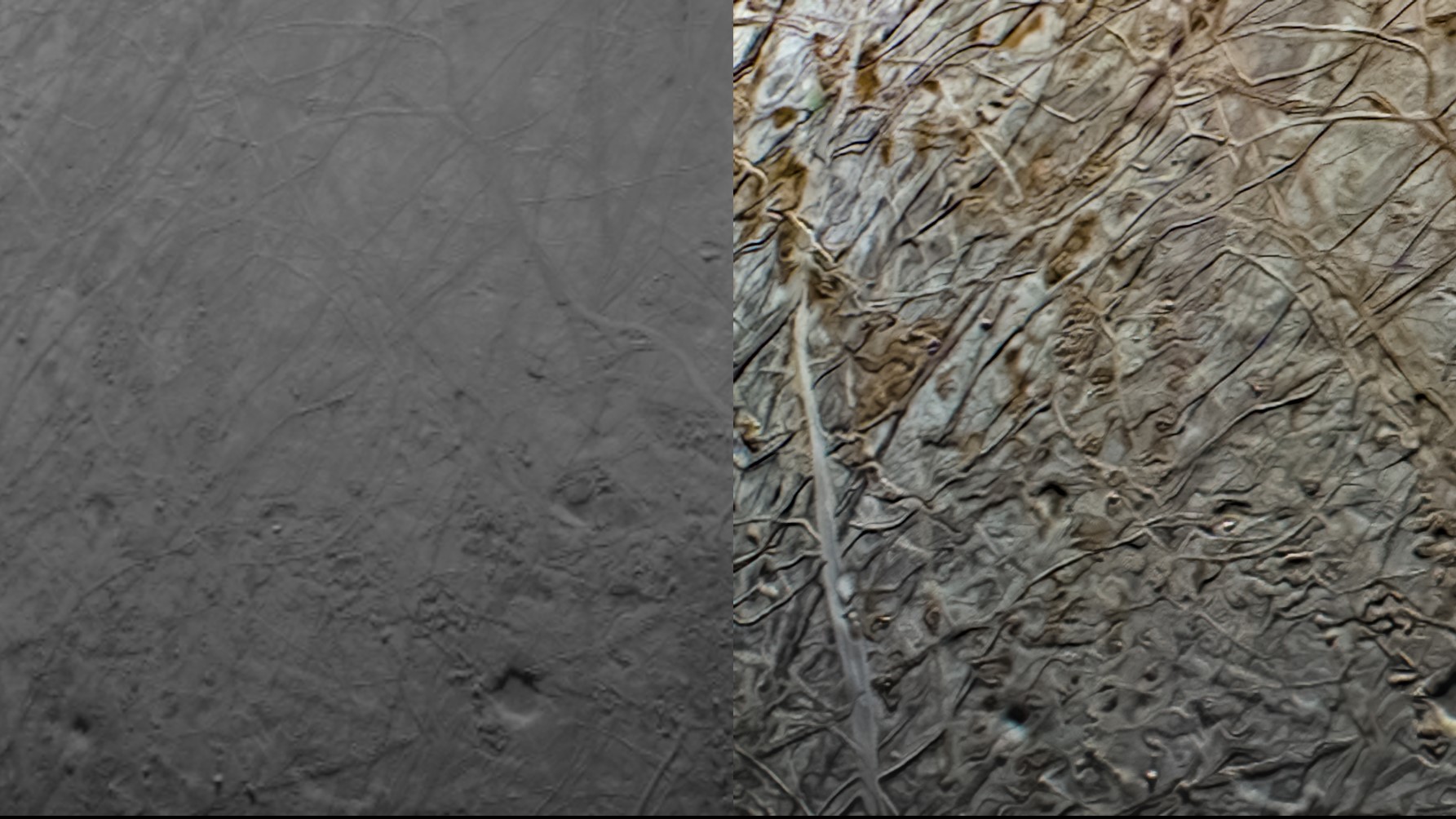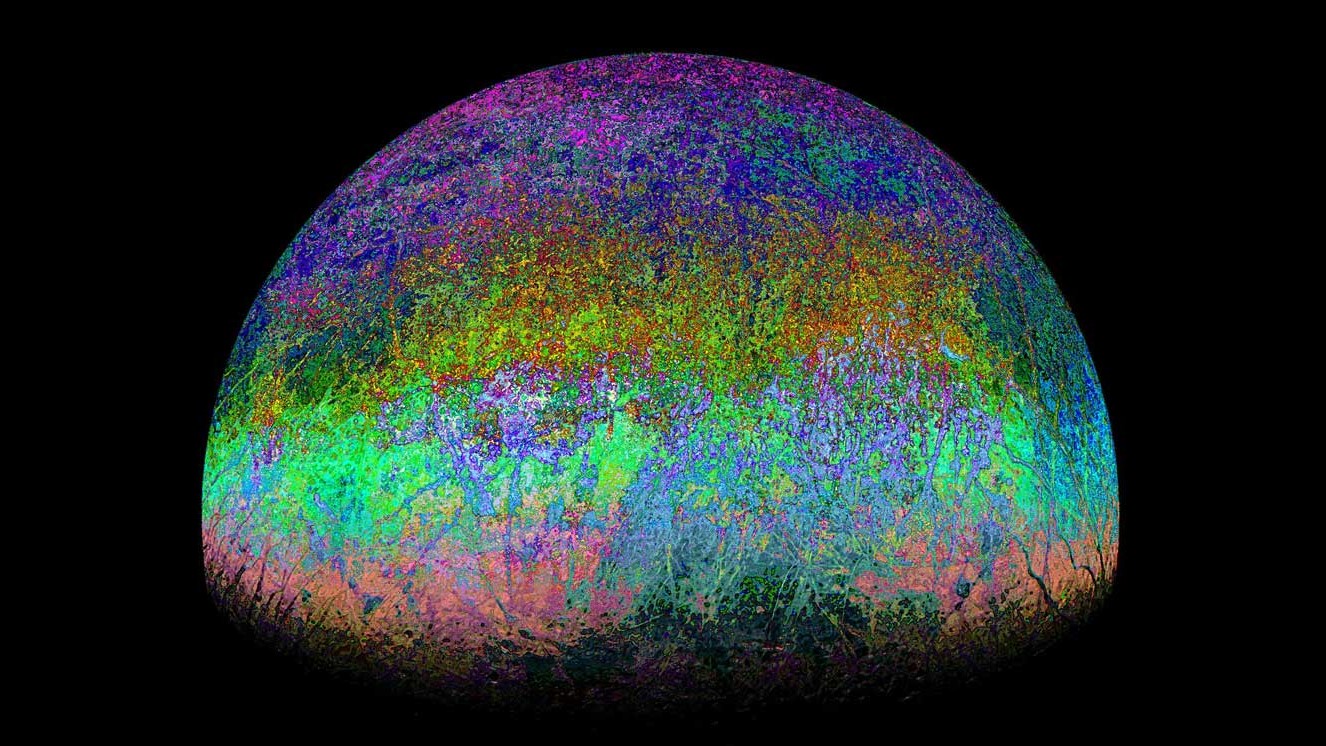Juno photos reveal more stunning glimpses of Jupiter's ice-covered moon Europa

Fabulous portraits of Jupiter's mysterious icy moon Europa captured by NASA's Juno mission during its close flyby last week reveals the moon, which may possibly harbor extraterrestrial life, in unexpected colors.
The new images were taken by Juno's JunoCam camera during the probe's pass of Europa on Sept. 29, then went to enthusiastic image processors who gave them at times an almost artistic treatment.
"Starting with our flyby of Earth back in 2013, Juno citizen scientists have been invaluable in processing the numerous images we get with Juno," Scott Bolton, Juno principal investigator from the Southwest Research Center in Texas said in a statement. "During each flyby of Jupiter, and now its moons, their work provides a perspective that draws upon both science and art. They are a crucial part of our team, leading the way by using our images for new discoveries."
Related: Underwater snow on Earth could offer insight into Europa's icy crust
The newly released images highlight previously unexplored surface features that could shed light on processes occurring in the potentially life-bearing ocean underneath Europa's thick ice crust. The images, taken during an imaging window just a few minutes long, include JunoCam's closest image of the moon, which was taken from an altitude of 945 miles (1,500 kilometers) above Europa's surface. The image shows a region called Annwn Regio, known for what scientists call chaotic terrain, a maze of ridges, grooves and cracks scaring the icy surface.
The image, processed by Björn Jónsson, depicts the surface with a resolution of about 0.6 miles (1 km) per pixel, revealing numerous bright and dark troughs and previously unknown pits. Callanish Crater, which NASA's Galileo probe studied in the late 1990s and early 2000s, appears in the lower right as a circular dark spot.
Two of the images show the same portion of Europa's surface, comparing different processing approaches; one with minimal treatment, the other with enhanced color contrast that makes the surface features stand out. In the more processed image, shadows cast by the hodgepodge of scars are visible.
Breaking space news, the latest updates on rocket launches, skywatching events and more!
Finally, a highly stylized image by Fernando Garcia Navarro lends the rather plain white and brownish moon an extravagant psychedelic look.
"Juno's citizen scientists are part of a global united effort, which leads to both fresh perspectives and new insights," Candy Hansen, lead co-investigator for the JunoCam camera at the Planetary Science Institute in Arizona, said in the statement. "Many times, citizen scientists will skip over the potential scientific applications of an image entirely, and focus on how Juno inspires their imagination or artistic sense, and we welcome their creativity."
Juno zipped 256 miles (412 km) above Europa's frozen surface last week, making its closest approach to the moon and the closest by any spacecraft since the Galileo spacecraft flew by in 2000. Hurtling through space at 15 miles per second (24 km per second), Juno snapped its most detailed image of Europa to date. The maneuver wasn't just for sightseeing; it also adjusted the probe's trajectory around Jupiter, reducing the time it takes to orbit the gas giant from 43 to 38 days, NASA said in the statement.
Last year, Juno visited Ganymede, the largest moon in the solar system; a visit to the volcanic moon Io is planned for next year.
While all four of the main Jovian moons are fascinating, Europa is particularly intriguing because scientists believe it might be the likeliest body in the solar system to host extraterrestrial life.
Juno is unlikely to address whether anything lives in the depths of Europa's ocean, but NASA's planned Europa Clipper mission, expected to launch in 2024, may be able to find the needed evidence. Fitted with a suite of nine cutting-edge scientific instruments, Europa Clipper will turn Europa into the best explored moon in the solar system with the exception of our own natural satellite.
Follow Tereza Pultarova on Twitter @TerezaPultarova. Follow us on Twitter @Spacedotcom and on Facebook.

Tereza is a London-based science and technology journalist, aspiring fiction writer and amateur gymnast. She worked as a reporter at the Engineering and Technology magazine, freelanced for a range of publications including Live Science, Space.com, Professional Engineering, Via Satellite and Space News and served as a maternity cover science editor at the European Space Agency.


